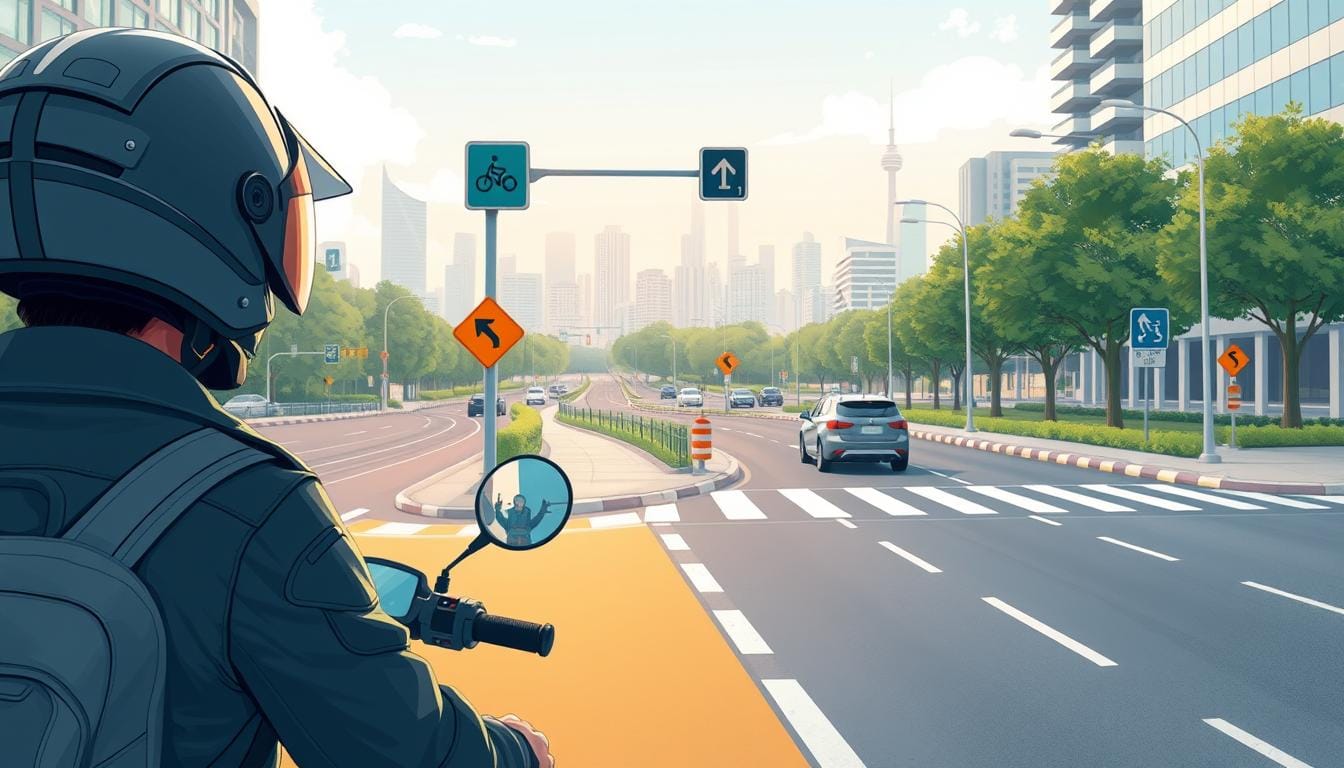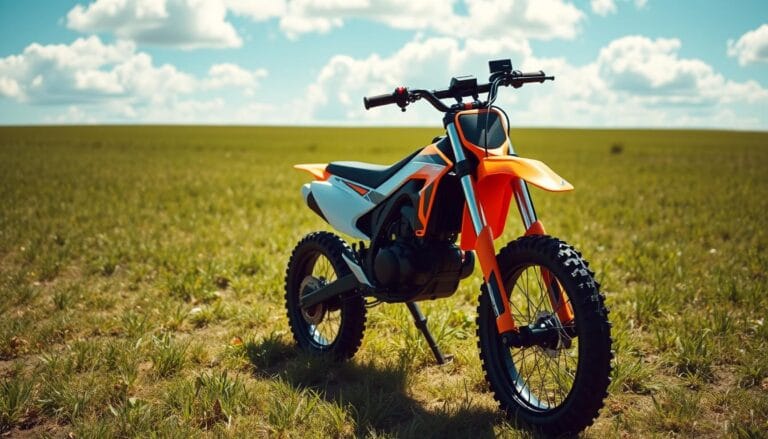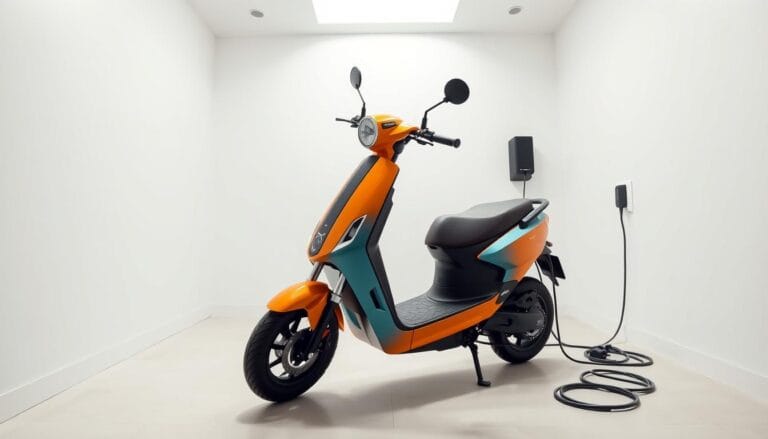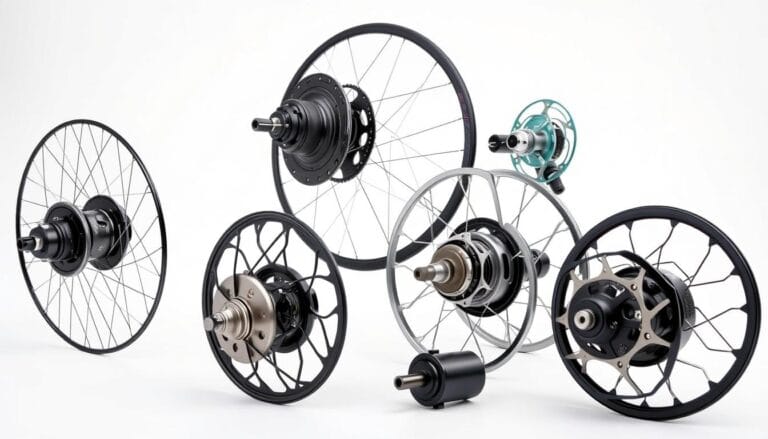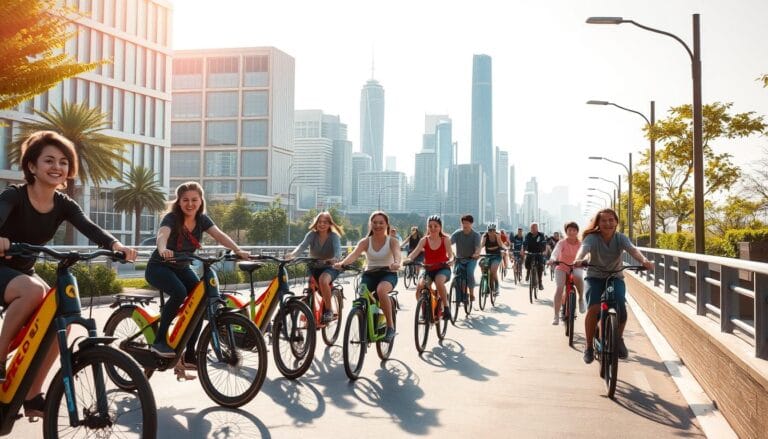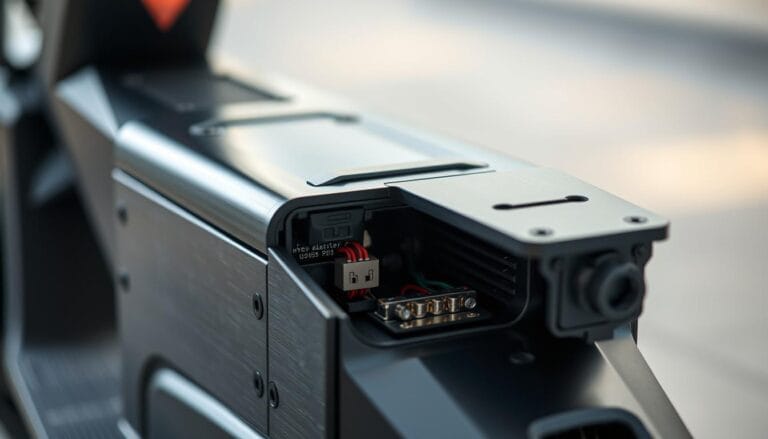Scooter Safety Tips: Ride Smart in 2025
Every time I hop on my electric scooter, I feel a rush of excitement. At the same time, I’m keenly aware of the responsibility that comes with it. Scooter safety tips are more important than ever, as the world of urban transportation changes.
The electric scooter world has changed a lot in recent years. Now, 28 states and Washington, D.C. have updated their e-scooter laws. This means accident prevention is a must, not just an option. Federal rules now classify electric scooters as low-speed vehicles, setting clear safety guidelines.
Whether you’re a seasoned rider or just starting out, knowing the latest safety tips is key. These tips aren’t just for your safety. They help make the road safer for everyone.
Key Takeaways
- Stay informed about local e-scooter regulations
- Always prioritize personal safety while riding
- Understand federal guidelines for electric scooters
- Invest in proper safety gear and equipment
- Be aware of your local traffic laws and riding zones
Understanding the Basics of Scooter Safety
Scooter riding is fun and a great way to get around cities. But, safety is always first. Electric scooters have changed how we move cities, bringing both benefits and risks.
Knowing scooter safety tips is key to avoiding accidents and staying safe. About 40% of scooter injuries come from mechanical problems. This shows how important it is to know the basics of safety.
Why Safety Matters
Safety is important because it affects you and those around you. Here are some reasons why:
- Protect yourself from potential injuries
- Ensure the safety of pedestrians and other road users
- Minimize the risk of accidents through proper awareness
- Contribute to a safer urban mobility ecosystem
Common Scooter Injuries to Avoid
Knowing the risks is key to staying safe. Riders face many injury risks that can be avoided with the right precautions:
| Injury Type | Prevention Strategy |
|---|---|
| Head Injuries | Wear a helmet (reduces risk by up to 70%) |
| Road Rash | Use protective clothing and gear |
| Mechanical Failures | Regular maintenance checks |
Distracted riding greatly increases accident risks. Studies show riders using phones are 3 times more likely to crash. Always stay focused, follow safety tips, and look out for your safety when riding.
Choosing the Right Scooter for Your Needs
Finding the right scooter means knowing what you need and focusing on safety. Your scooter should fit your lifestyle, where you ride, and how you move. It’s also important to keep you safe.
Electric vs. Kick Scooters: Making the Right Choice
There are two main types of scooters: electric and kick scooters. Each has its own benefits for different riders.
- Electric Scooters:
- Can go up to 20 mph
- Has a motor up to 750W
- Best for longer trips
- Kick Scooters:
- You power it yourself
- Light and easy to carry
- Perfect for short rides
Essential Safety Features to Consider
When picking a scooter, look for these key safety features. They help make sure you ride safely.
| Feature | Safety Impact |
|---|---|
| Reliable Braking System | Helps stop quickly and avoid accidents |
| Sturdy Construction | Makes it stable and long-lasting |
| Proper Lighting | Makes you more visible when it’s dark |
| Anti-Tip Wheels | Helps prevent tipping over and keeps you safe |
Your scooter is a big deal for getting around and staying safe. Take your time to look at different models, read what others say, and try them out. This way, you’ll find the scooter that’s just right for you.
Essential Gear for Safe Riding
When you ride a scooter, safety is key. The right gear, like helmets and accessories, can prevent injuries. This ensures a safe ride.
The Importance of a Helmet
Your helmet is the most important safety item. Electric scooters can go fast, over 16 mph. Statistics show 40% of scooter accidents happen to riders without helmets.
When picking a helmet, look for these features:
- Proper fit with secure chin strap
- Full head coverage
- Impact-resistant materials
- Ventilation for comfort
Protective Clothing and Accessories
Wearing the right clothes and accessories is also vital. A survey found 70% of riders don’t wear knee and elbow pads. This increases their risk of getting hurt.
- Wear long pants and sleeves for skin protection
- Use knee and elbow pads
- Choose closed-toe shoes with good grip
- Consider padded riding gloves
Other Recommended Safety Gear
Being seen is crucial, even in the dark. Reflective clothes can make you 70% more visible. This lowers the risk of accidents. Think about adding:
- Reflective vest or jacket
- LED lights for front and rear
- Bright or high-contrast clothing
- Helmet with reflective elements
Safety isn’t expensive, it’s priceless. Invest in quality gear to protect yourself while enjoying your ride.
Maintaining Your Scooter for Optimal Safety
Keeping your scooter in top shape is key for your safety on the road. Regular checks help avoid breakdowns and accidents. Spending a little time on routine inspections can make your scooter last longer and keep you safe.
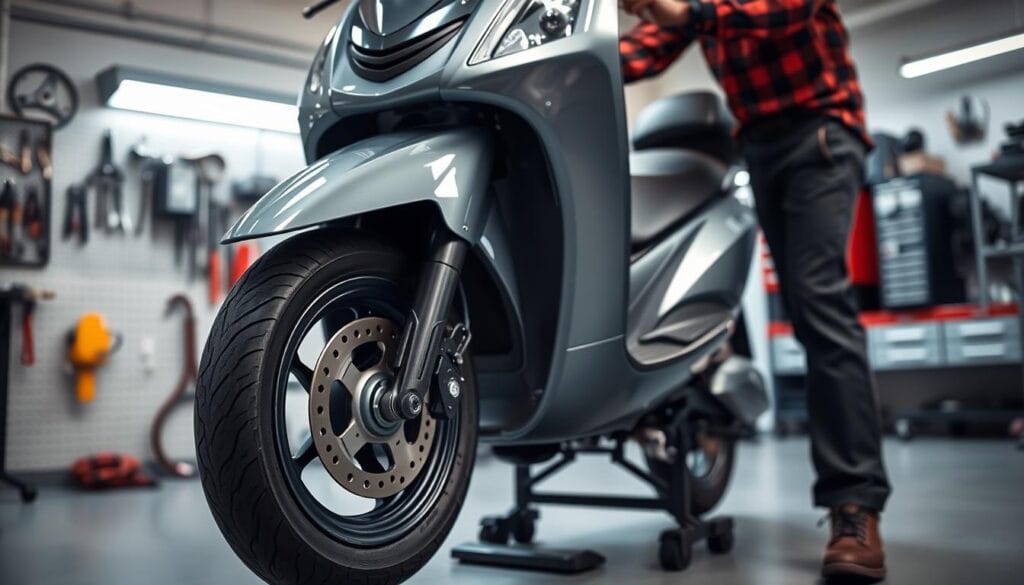
- Inspect your scooter before each ride
- Check tire pressure and wear
- Examine brake functionality
- Verify all electrical connections
- Clean and lubricate moving parts
Essential Inspection Techniques
Doing maintenance checks doesn’t need advanced skills. Start with a visual check of your scooter’s main parts. Look for wear, loose bolts, or damage that could affect your safety.
Brake and Tire Maintenance
Your scooter’s brakes and tires are vital for safety. Check brake pads for wear and make sure they stop well. For tires, look at:
- Proper inflation
- Tread depth
- Any visible cracks or damage
- Smooth rotation without wobbling
Pro Tip: If you’re unsure about any maintenance procedures, consult a professional scooter technician to ensure your safety.
Regular maintenance keeps you safe and improves your scooter’s performance and life. Set a regular maintenance schedule to find issues early.
Knowing Your Riding Environment
Understanding your riding environment is key for scooter safety. Different places have their own challenges. You need to know the road rules and scooter laws to stay safe.
When you ride in cities and countryside, you must be careful. The place you ride in affects your safety and how you feel. It’s important to adjust your riding to match the environment.
Urban Riding Considerations
City riding is complex. You need to be extra careful. Here are some safety tips:
- Ride as close to the right curb as possible
- Avoid designated bike lanes
- Obey all traffic signals and street markings
- Yield to pedestrians at crosswalks
Understanding Road Rules and Regulations
Every place has its own scooter laws. It’s important to know these rules. Key regulations include:
- Age restrictions (usually 16-18 years old)
- Speed limits (usually 15-20 mph)
- Helmet requirements
- Designated riding areas
Pro tip: Always check local regulations before riding, as rules can vary significantly between cities and states.
Safety isn’t about following rules blindly—it’s about understanding why those rules exist to protect you and others.
By learning the road rules and adjusting to your environment, you’ll ride safer and more confidently.
Developing Safe Riding Habits
Learning safe riding techniques is key for scooter safety and avoiding accidents. Being aware and communicating well on the road can greatly lower the chance of crashes and injuries.
Staying Alert: Your First Line of Defense
Being aware of your surroundings is your strongest defense when riding a scooter. 80% of fatal e-scooter crashes involve collisions with cars. So, staying alert can save your life.
- Scan the road continuously for potential hazards
- Avoid riding in drivers’ blind spots
- Maintain a safe distance from vehicles
- Watch for pedestrians, road obstacles, and unexpected movements
Effective Communication on the Road
Signaling properly is crucial for safe sharing of the road. Your signals can prevent misunderstandings and accidents.
- Use clear hand signals when turning or stopping
- Make eye contact with drivers when possible
- Use reflective gear to increase visibility
- Wear bright clothing, specially in low-light conditions
“Your safety depends on your ability to predict and prevent potential road hazards.”
By using these riding techniques and staying alert, you can greatly lower your risk of accidents. This way, you can enjoy a safer scooter ride.
Riding in Different Weather Conditions
Riding a scooter in various weather needs skill and prep. Weather greatly changes your ride and safety. Knowing how weather affects your scooter is key for safe riding.
How Rain Affects Scooter Performance
Rain is tough for scooter riders. Wet roads can cut tire grip by half, making falls more likely. Since no scooter is waterproof, be careful.
- Slow down in the rain
- Wear waterproof, reflective clothes
- Check tire tread before riding
- Use lights for better visibility
“Safety begins with awareness and preparation” – Scooter Safety Experts
Tips for Riding Safely in Windy Conditions
Wind makes riding harder. It’s harder to balance and control your scooter in strong winds.
- Lean slightly into the wind direction
- Grip handlebars firmly
- Wear close-fitting clothing
- Slow down in high winds
Adapting your ride and knowing weather challenges makes scooter riding safer in all conditions.
Tips for Night Riding Safety
Riding a scooter at night is different and requires more safety focus. Being seen is key when it’s dark outside. The right gear and accessories can help prevent accidents.
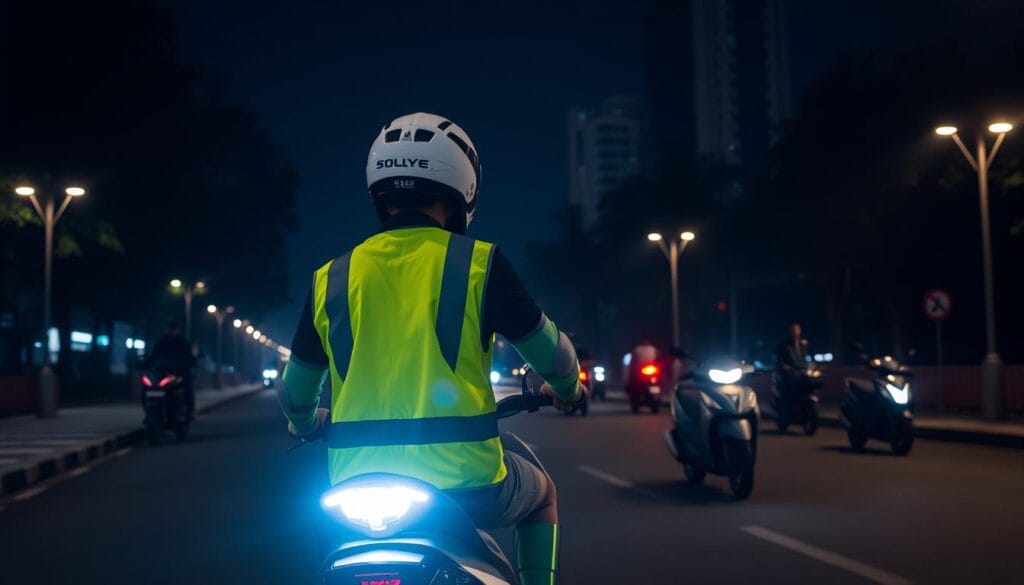
Statistics show a big risk at night. Almost half of scooter accidents happen between 10 PM and 6 AM. Riders are twice as likely to get hit by a car at night. This highlights the need for good safety tips for riding at night.
The Importance of Visibility
Light can drop by up to 90% in dark places. To stay safe, try these tips:
- Wear reflective clothes to be seen better by 200-300%
- Use bright lights wisely
- Choose well-lit routes
- Go slower at night
Choosing Proper Lighting for Your Scooter
Choosing the right lights is key for safety at night. Many places have rules for scooter lights after dark.
| Scooter Model | Lighting Features | Visibility Range |
|---|---|---|
| Apollo Pro | Customizable lighting | 300 feet |
| Apollo Phantom | 1000-lumen headlight | 250 feet |
| Apollo City 2024 | 360-degree lighting | 275 feet |
Being seen from 500 feet away can lower crash risks. Remember, your safety depends on being visible and predictable to other road users.
Handling Emergencies While Riding
Scooter safety is more than just preventing accidents. Knowing how to act in unexpected situations is key. It can save lives and prevent injuries. Learning the right steps can help you handle emergencies well.
What to Do in Case of an Accident
If you’re in a scooter accident, act fast. Here are the important steps:
- Move away from traffic to stay safe
- Check if you or others are hurt
- Call for help if injuries are serious
- Take photos of the scene
- Share contact and insurance details
“Safety is not an accident, but a deliberate choice of preparation and awareness.” – Road Safety Expert
How to Report Safety Hazards
Telling authorities about safety issues helps everyone. Use these ways to report:
- Local transportation department
- City’s 311 non-emergency service
- Online reporting platforms
- Municipal website safety sections
| Injury Type | Percentage | Recommended Action |
|---|---|---|
| Head Injuries | 25% | Seek immediate medical attention |
| Arm/Hand Injuries | Almost 50% | Stabilize and assess mobility |
| Leg/Foot Injuries | 25% | Apply RICE method (Rest, Ice, Compression, Elevation) |
Remember: Your safety is the most important thing. Always put your well-being first and follow the rules.
Continuous Learning for Safer Riding
Staying safe on scooters means always learning more. Rider training programs teach you about scooter laws and safety tips. Keeping up with new scooter rules can greatly improve your safety.
Local departments and scooter makers offer safety courses. These teach you how to ride safely in cities, follow speed limits, and know the rules. You’ll learn about checking your scooter before riding, the importance of tire pressure, and spotting dangers on the road.
Joining Safety Workshops
Find hands-on scooter safety training in your area. Many cities have free or cheap workshops on important topics like riding at night, wearing helmets, and age limits. Brands like Apollo Pro and Apollo Phantom often host these events to help you ride smarter.
Staying Updated on Guidelines
With 28 states changing e-scooter laws in 2024, staying informed is key. Sign up for local transport newsletters, check city websites, and join scooter forums. Learning more can lower your accident risk and make riding safer.

